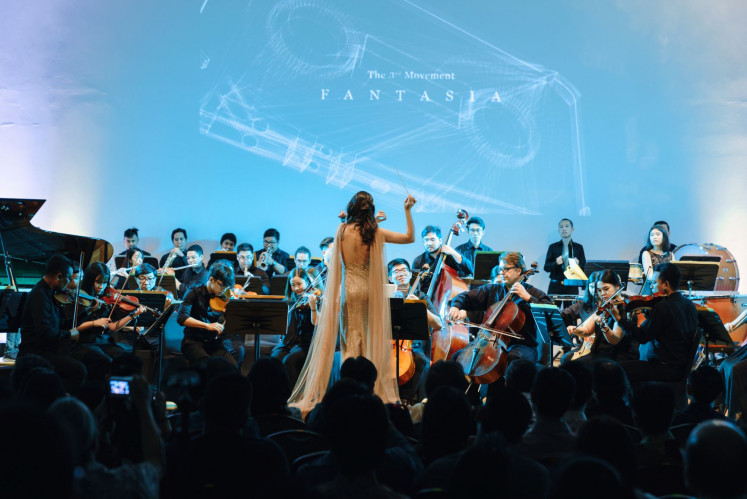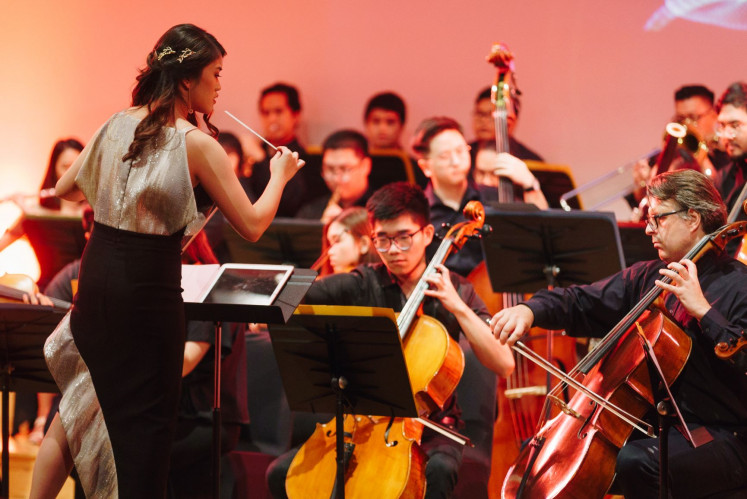
[ad_1]
The orchestral scores by composer Chikita Amanda somehow bring back to mind Hollywood and Disney film soundtracks whose cinematic and multimedia pervasiveness in society make them ubiquitous.
Marked by harmony with a direct melody as a leitmotif and repetitive variations thereof, her orchestral compositions are designed to form a narrative.
“Bloodshed”, for instance, describes the dynamics of a war that conjures up moving images of two opposing forces readying and positioning themselves for combat, marching and fighting against each other.
Then, as the battle progresses, the guns suddenly fall silent. As if cutting the battle short, an aftermath-of-war-like, delicate interval prevails for a while, before the fighting continues, increasingly more intense and finally reaching its climax.
Premiered in a senior recital named Eclectic at Kertanegara Recital Hall in South Jakarta last year, “Bloodshed” showcases some scoring influence of American superhero film Captain Marvel. Which is hardly surprising, because Chikita’s favorite composer is the female Turkish composer of the blockbuster movie, Pinar Toprak.
The influence of some other film composers, such as Alan Menken, David Foster, John Powell and Hans Zimmer, is also observable, not only in “Bloodshed” but also in her other orchestral works.
Born in Manado on Dec. 9, 1997, Chikita stands out among young Indonesian composers, most of whom are men.
The iGen composer who studied music composition at Pelita Harapan University’s Conservatory of Music writes music for singles and commercials and collaborates with other musicians on projects. She recently submitted her thesis.
“I like all types of music and listen to many different genres,” she said.
 Adventurous: In ‘Fantasia’, Chikita presents a marching sound one would usually hear in a war film. (Courtesy of Dave Christian Obadja/-)
Adventurous: In ‘Fantasia’, Chikita presents a marching sound one would usually hear in a war film. (Courtesy of Dave Christian Obadja/-)
Before the COVID-19 pandemic, she was active doing recitals.
“I used to participate in more than 10 recitals per semester, either as a performer, music arranger or composer,” she said. No wonder her father calls her “recital queen,” which she shyly and reluctantly accepts.
Her music and orchestral compositions in particular are Western in taste, as apparent in her latest collaboration with violinist Mario Lasar, which culminated in a video clip featuring the East Nusa Tenggara ethnic song “Bolelebo”.
In Chikita’s orchestral arrangement (which includes sounds of a soothing breeze and birds chirping), mixing and mastering of the folk song combines traditional tunes and electronically programmed modern orchestration in an exoticizing way that satisfies Western musical appetite.
This incorporation of ethnic tunes into the culturally ubiquitous Western music ideals makes the sense of home that the song evokes highly palatable for middle-class urbanites who are accustomed to new age music and light music.
It’s interesting to note that “Bolelebo” is a role-reversal exercise for both Chikita and Mario.
“Bloodshed” puts the spotlight on Chikita as the conductor of the orchestra, making Mario the invisible concertmaster. But in “Bolelebo”, Chikita allows herself to be an “invisible” accompanist to Mario.
If you go to the comments section of its YouTube video, all the credits go to Mario and only one to Chikita and Mario, which is how a supporting role is supposed to be: unseen and yet very much present.
 Feel the heat: The reddish color of the lighting intensifies the impression of a consuming fire suggested by ‘Combust’, Chikita’s orchestral work. (Courtesy of Dave Christian Obadja/-)
Feel the heat: The reddish color of the lighting intensifies the impression of a consuming fire suggested by ‘Combust’, Chikita’s orchestral work. (Courtesy of Dave Christian Obadja/-)
In “Jatuh Cinta” (Falling in Love) and “Lukisan Pagi” (Morning Picture), two songs by guitarist and composer Tohpati Ario Hutomo, she also makes her presence invisible but charmingly heard through the easy-listening, melodious arrangement of the bitter-sweet soliloquy.
Yet, her jam session-like, funky jazz composition titled “The Many Sides of Me” performed in her 2018 junior composition recital is a dead giveaway that the music she likes boils down to one personal preference: big band jazz instrumental.
However, she insisted that “The Many Sides of Me” represents just one side of her, not the one she identifies herself with musically.
“It was just an exploration into another genre. The jam session-like part is aimed at highlighting the musicians’ abilities,” she says, adding that her music is “usually cinematic”, which is why she calls herself a “cinematic composer”.
Of all the music she has composed, there is one with distinctively Spanish flavor. However, none is fully inspired by the traditional ethnic music from her own backyard.
She recalled that there was one inspired by the ethnic music of Java and Bali that she composed in 2011 for piano and electone, but there is no video of the performance. “Perhaps I will explore this genre more deeply in the future,” she said. (ste)
Your premium period will expire in 0 day(s)
close x

Subscribe to get unlimited access Get 50% off now
[ad_2]
Source link